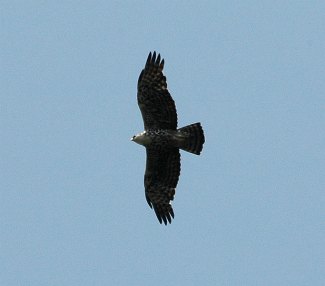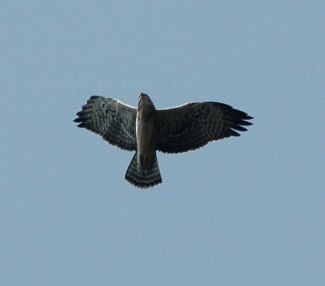Ayres’s Hawk Eagle - Aquila ayresii
By Aviceda, CC-BY-SA-3.0, via Wikimedia Commons
Family: Accipitridae
Genus: Aquila
Species: A. ayresii
Ayres's Hawk Eagles are small to medium sized, brown-and-white eagles that live across sub-Saharan Africa. They form a clade with Aquila pennata (Booted Eagle) and Aquila morphnoides (Little Eagle); Aquila wahlbergi (Wahlberg’s Eagle) is a sister species.
Physical Description:
The head of Ayres’s Hawk Eagles is brown with a white throat and a small, inconspicuous crest. The eyes are bright yellow and the beak is gray with a black tip. The breast and wings are heavily streaked with black. The back and wings are brown with dark primary feathers, and the undertail has a black trailing edge.
Juveniles are gray-brown from above with rufous crown, nape, and mantle (back). The underparts are streaked with rufous, with thin barring on the breast and flanks.
Size:
Length: 44-57 cm
Wingspan: 106-137 cm
Weight: .685-1.05 kg
Habitat and Distribution:
Ayres’s Hawk Eagles live in dense evergreen forests, forest edges, clearings, eucalyptus plantations, forest islands, developed woodland, and on wooded hillsides. They are solitary birds outside of the breeding season and will establish non-breeding territories in a range of habitats.
They are widespread across sub-Saharan Africa but their distribution is patchy and sparse. There are approximately 1,000-10,000 individuals, from 14°N to 25°S, at 0-3,000 meters above sea level.
Diet and Hunting:
Doves, pigeons, thrushes, starlings, hornbills, bulbuls, African barbets, African hoopoe, and shikras, all of which are birds, make up much of the diet of Ayres's Hawk Eagles. They also eat some tree-dwelling rodents and bats.
They hunt by finding their prey from the air, and then pulling their wings close to the tail to form a heart-shaped silhouette as they dive almost vertically toward the ground. They will also weave in and out of the branches of the forest they inhabit and grab their prey in flight. In addition, some hunting is done from a hidden perch, from which they will make a sudden dive for prey.
By Aviceda, CC-BY-SA-3.0, via Wikimedia Commons
Reproduction:
The breeding season begins in the cooler months of the year, during the dry season. Pairs are monogamous, although Ayres’s Hawk Eagles are solitary and are often found alone.
The nest is made of sticks and twigs and lined with green leaves. It is usually set in the fork of a tree and is relatively unstable; nests have been known to collapse before the end of the season. Pairs often use the same nest repeatedly, even if there are changes to the environment or the nest itself. A single dull-white, brown-spotted egg is laid between April-September, and the peak egg-laying season is from April-May. The egg is incubated for 43-45 days. The chick leaves the nest after 73-75 days and becomes fully independent around three months later.
Conservation:
Due to a large range and a population that is apparently stable, Ayres's Hawk Eagles have been listed as Least Concern by the BirdLife International. However, their habitat is shrinking as woodland is lost, and the birds are persecuted for killing domestic birds such as homing pigeons.
Taxonomy:
Based on a study using DNA sequences from one mitochondrial and two nuclear genes, A. ayresii, Aquila pennata (Booted Eagle), and Aquila morphnoides (Little Eagle) were shown to form a monophyletic clade, with Aquila wahlbergi (Wahlberg’s Eagle) as a sister species.
All of the above species were formerly considered part of genus Hieraaetus but many authorities now consider them part of Aquila. Therefore, species that belonged to Hieraaetus are classified under Aquila on this website.
Aquila ayresii was named after naturalist Thomas Ayres, who lived from 1828-1918.
Other Names:
Kleinjagared (Afrikaans), Orel skvrnitý (Czech), Brun Høgeørn (Danish), Ayres-Havikarend (Dutch), Aafrika kääbuskotkas (Estonian), Afrikanpikkukotka (Finnish), Aigle D'Ayres (French), Fleckenadler (German), Aquila minore di Ayres (Italian), Shiroharakumataka (Japanese), Flekkørn (Norwegian), Orzelek plamisty (Polish), Águia de Ayres (Portuguese), Águila-azor de Ayres (Spanish), Tai-msitu (Swahili), Ayres dvärgörn (Swedish).
Other Multimedia:
None available.
References:
http://www.arkive.org/ayress-hawk-eagle/hieraaetus-ayresii/
http://avibase.bsc-eoc.org/species.jsp?avibaseid=7DF004036707FA39
http://www.biodiversityexplorer.org/birds/accipitridae/aquila_ayresii.htm
http://birds.intanzania.com/finding-ayres-hawk-eagle
Global Raptor Information Network. 2011. Species account: Ayres's Hawk-eagle Aquila ayresii. Downloaded from
http://www.globalraptors.org on 22 Jul. 2011
BirdLife International 2009. Hieraaetus ayresii. In: IUCN 2011. IUCN Red List of Threatened Species. Version 2011.1.
www.iucnredlist.org. Downloaded on 22 July 2011.
http://www.namibian.org/travel/birds/ayress-hawk-eagle.html
http://www.planetofbirds.com/accipitriformes-accipitridae-ayress-hawk-eagle-hieraaetus-ayresii
Ferguson-Lees, James, and Christie, David A. Raptors of the World. Houghton Mifflin Company, 2001.
http://www.thekruger.com/knpbirds/aquilaayresii.htm

